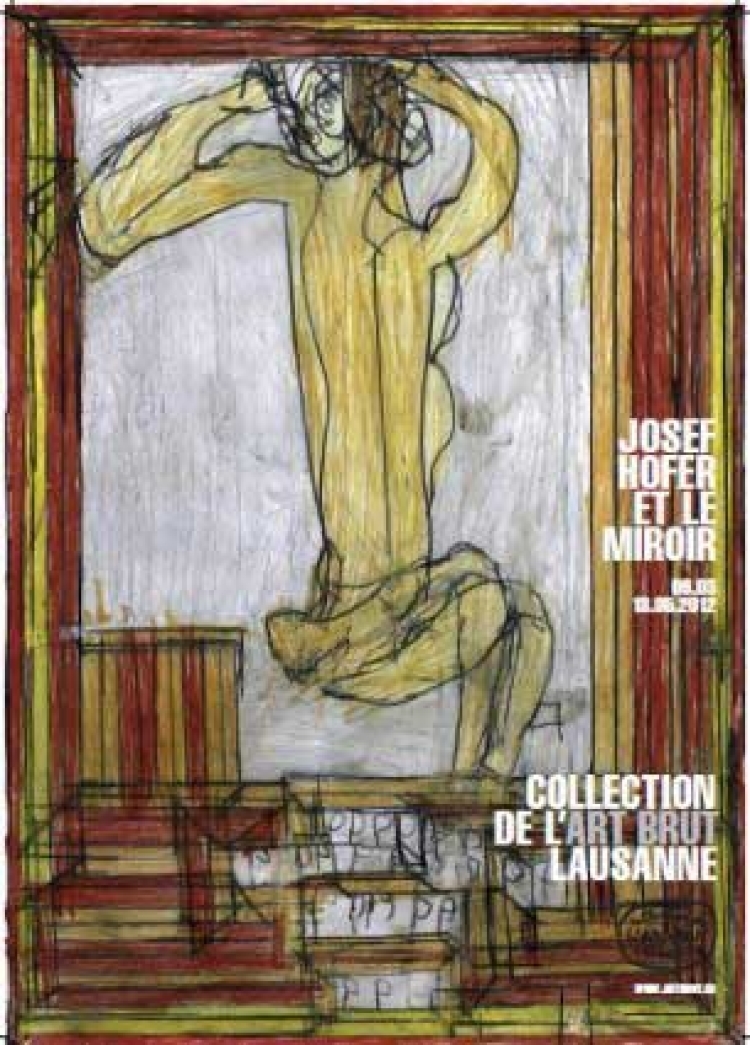Josef Hofer and the Mirror - March 9 through May 13, 2012

The exhibition presented by the Collection de l’Art Brut features some fifty of Josef Hofer's drawings centered on the male human figure and sexuality. Born in 1945 and pursuing his activity in Austria, Hofer is considered to be one of the most important discoveries over the last ten years. It is thanks to donations of his works by the art historian Elisabeth Telsnig, who heads the creative activities workshop where he works, that the Collection de l'Art Brut today holds around one hundred of his creations. Josef Hofer and Elisabeth Telsnig will both be attending the opening reception.
Through her many donations of works, Elisabeth Telsnig, art historian and head of the creative activities workshop at the community facility in Ried (Austria) that Hofer attends weekly, has over the years enabled the Collection de l'Art Brut to build up its holdings of Josef Hofer's creations. In 2003, the Collection de l'Art Brut proudly displayed for the first time this creator's oeuvre. The present show, Joseph Hofer and the Mirror, composed exclusively of works belonging to the Collection, promises to reveal a whole new facet of his oeuvre.
The drawings on display deal with Hofer's current favorite theme: the male figure. Generally, the bodies despicted are nudes. In point of fact, these are self-portraits that focus on sexuality—a subject that has become his oeuvre's unique central and obsessional topic.
The bodies that Hofer draws in lead pencil always fit into a frame that emerges progressively in step with the author's creative evolution. Although a hint of such frames appeared already in 2002, they only show up systematically as of 2003; in his latest pieces (2011), they take up all of the space, relegating the human figure to the background.
The frame actually represents a mirror which, holding pride of place in his room, serves as a source of inspiration to Hofer for his compositions. It stands directly on the floor and faces his bed, enabling him to see himself in it daily and for hours at a time. Fetishistically attached to this mirror, with its two wooden folding flaps similar to those on dressing tables, Hofer depicts it in his drawings in the form of a large rectangle that frames his figures. He outlines their shape in numerous lead pencil lines, using a stick of wood as a ruler, and always colors them in the same shades, preferring orange and yellow. Interestingly, the frame shape changes depending on the pose struck by the subject within it, although the figures nonetheless come across as if constricted. Indeed, the bodies are often truncated, amputated of their head or lower limbs; their reconstruction depends on how Hofer sees himself in the mirror. Hofer works extremely slowly, elaborating his compositions with a good dose of perseverance. Often, he uses the nickname "Pepi" to sign his works.
Through her many donations of works, Elisabeth Telsnig, art historian and head of the creative activities workshop at the community facility in Ried (Austria) that Hofer attends weekly, has over the years enabled the Collection de l'Art Brut to build up its holdings of Josef Hofer's creations. In 2003, the Collection de l'Art Brut proudly displayed for the first time this creator's oeuvre. The present show, Joseph Hofer and the Mirror, composed exclusively of works belonging to the Collection, promises to reveal a whole new facet of his oeuvre.
The drawings on display deal with Hofer's current favorite theme: the male figure. Generally, the bodies despicted are nudes. In point of fact, these are self-portraits that focus on sexuality—a subject that has become his oeuvre's unique central and obsessional topic.
The bodies that Hofer draws in lead pencil always fit into a frame that emerges progressively in step with the author's creative evolution. Although a hint of such frames appeared already in 2002, they only show up systematically as of 2003; in his latest pieces (2011), they take up all of the space, relegating the human figure to the background.
The frame actually represents a mirror which, holding pride of place in his room, serves as a source of inspiration to Hofer for his compositions. It stands directly on the floor and faces his bed, enabling him to see himself in it daily and for hours at a time. Fetishistically attached to this mirror, with its two wooden folding flaps similar to those on dressing tables, Hofer depicts it in his drawings in the form of a large rectangle that frames his figures. He outlines their shape in numerous lead pencil lines, using a stick of wood as a ruler, and always colors them in the same shades, preferring orange and yellow. Interestingly, the frame shape changes depending on the pose struck by the subject within it, although the figures nonetheless come across as if constricted. Indeed, the bodies are often truncated, amputated of their head or lower limbs; their reconstruction depends on how Hofer sees himself in the mirror. Hofer works extremely slowly, elaborating his compositions with a good dose of perseverance. Often, he uses the nickname "Pepi" to sign his works.
Practical Information
Dates
From March 9 to May 13, 2012
Vernissage on March 8, 2012 at 6.5 pm
Curator
Sarah Lombardi
Exhibition Book
Elisabeth Telsnig, Wieland Schmied, Karl Kleinkofer, Josef Hofer, Schärding, Autriche, Galerie am Stein, 2011.
Film / DVD
Reflections from the Outside, de Chris Lewis, 42min., Crewhouse Media, 2007, version originale allemande, sous-titré en français par la Collection de l’Art Brut.Events
Michel Thévoz, premier conservateur de la Collection de l’Art Brut (1975-2001), donne une conférence intitulée Le Miroir onaniste, jeudi 29 mars 2012, 19h.Free Guided Tour
On April 26, 2012, at 7 pmPartenaires
Boutique
Enseignants
Accessibility
The exhibition Josef Hofer and the Mirror is not accessible to people with reduced mobility.